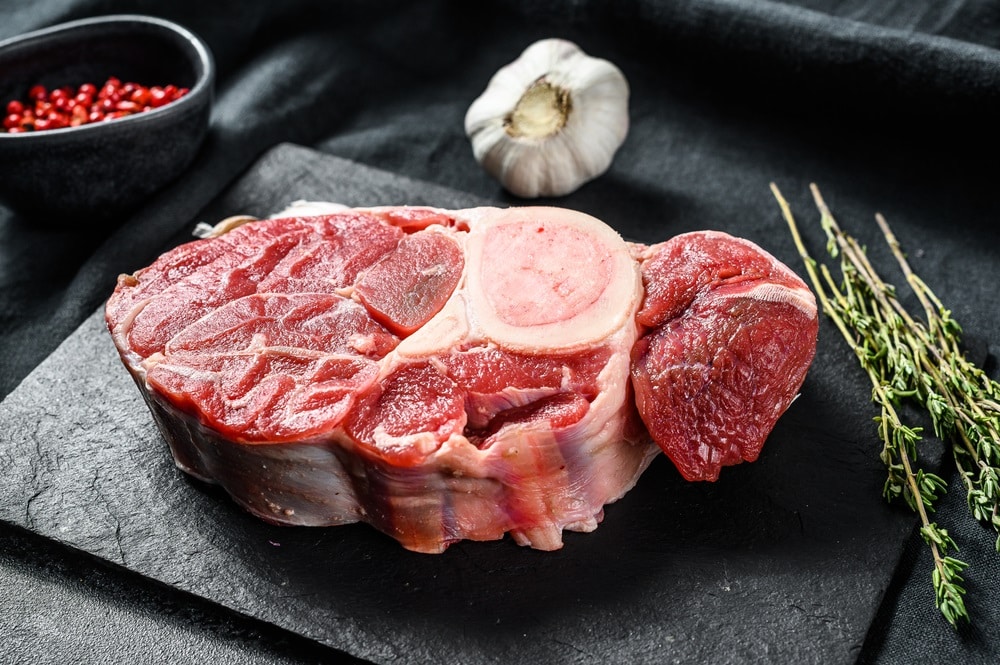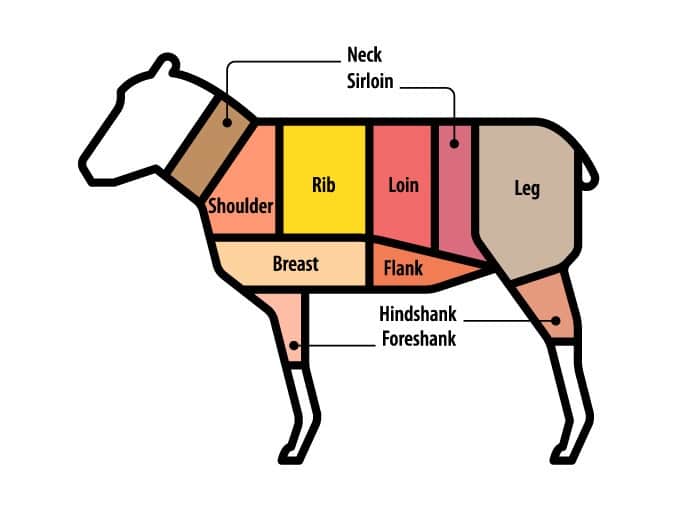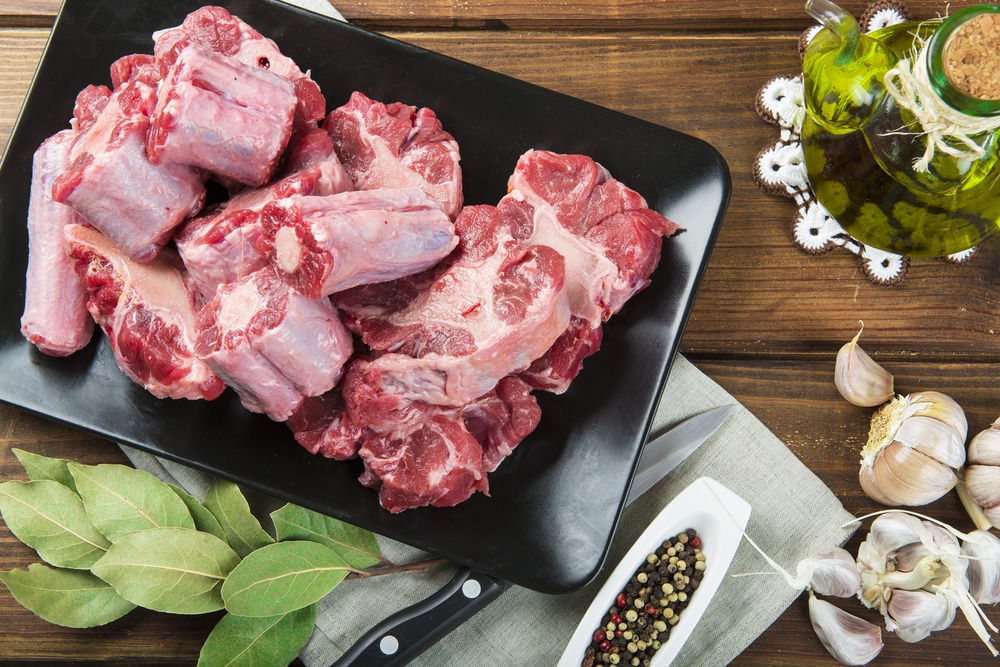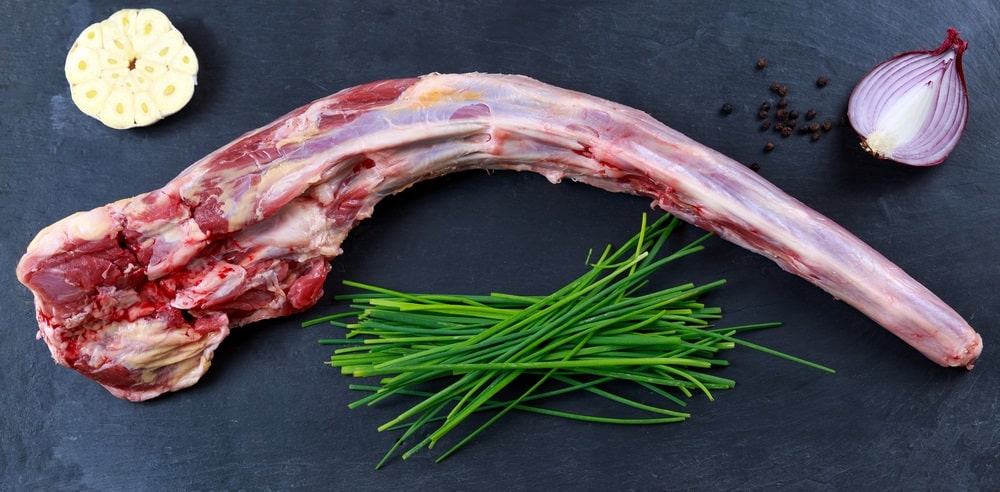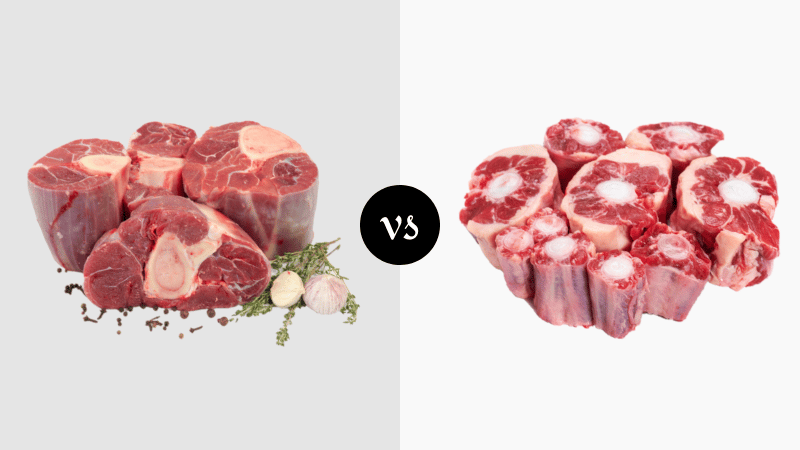
Meat lovers are always specific about the cut of beef preferred for any given meal, but the majority of people have no idea about the specifics of different beef cuts. This is why you find beef shank vs. oxtail being widely confused.
We have got all the details about the similarities and differences between these two very different cuts of meat coming up. By the time you’ve got through our comparison, you’ll always know when either variety is the better choice for any given meal.
Beef Shank Vs. Oxtail Comparison
| Beef Shank | Oxtail | |
| Names | Beef Shank, Shank, Foreshank, Hindshank, Cross Cut Shank, Osso Bucco, Meaty Bones, Soup Bones | Oxtail, Cow Tail, Beef Tail, Cattle Tail, Food Of The Gods |
| Cut | Cut Extracted Cow’s Leg From Region Above Knee But Beneath The Brisket. | Round Cut From Cattle’s Tail Inclusive Of Vertebrae & Connecting Muscle+Sinew |
| Size | 20 Pounds (Bone-In) | 7-8 Pounds |
| Flavor | Rich, Strong Beefy Flavor That’s So Boldly Beefy It’s Often Perceived As Gamey | Bold Beefy Rich Sweet Meat With Stronger Flavor But Less Gaminess Than Shank (Similar To Shortrib) |
| Tenderness | Dry, Tough Texture | Meaty But Fatty Texture Similar To Short Rib But Silkier |
| Best Uses | Lean Cut Best Suited To Hamburger Mince, Making Stock, Soups, Stews – Favored For Beef Bourguignon | Multipurpose Versatility | Stews, Soups, Stock | Favored In Roman & Italian Dishes | Frequently Cooked in Indonesia, South America, China, Korea, South Africa, West Africa, Spain |
| Variations | Frontshank, Hindshank | Bone-In, Deboned | Chunks Or Whole, Skinned Or Unskinned |
| Tips | Slow Cooking Or Pressure Cooking Highly Recommended, Braising Also A Worthy Cooking Option | Best Prepared Slow-Cooked Or Braised | Braising Ingredients Integral To Final Flavor |
| Substitutions | Beef Arm, Oxtail, Chuck, Silverside, Skirt Steak | Beef Shank, Beef Short Ribs WIth Bones, Beef Neck Bones, Beef Cheeks, Lamb Shank, Lamb Neck |
| Affordability | $6-$7 Per Pound (Cheaper Than Oxtail) | $5-$20+ Per Pound ($10-$20 In The US) |
Beef Shank Vs. Oxtail
Both beef shank and oxtail offer immense flavor to anyone looking to cook up a hearty soup, stew, or stock. Each of these options holds immense potential, but it’s knowing how and when to use which cut that makes all the difference.
Our overview covers all the differences and similarities so that you know exactly when to pick which to guarantee a perfectly balanced meal.
Beef Shank
There are so many ways to use beef shank. It’s easily one of the most inexpensive cuts of meat around, and if you cook it properly, there’s so much flavor to be enjoyed that it may just become your next favorite.
Let’s take a closer look at beef shank, its defining characteristics, and how this versatile, cheap piece of meat compares to oxtail.
Names
Beef shank is typically marked as shank, shank crosscut, beef Osso Bucco, foreshank, or hindshank. You’ll also sometimes find it sold as soup bones or meaty bones.
Cut
Beef shank is a cut that’s extracted from the leg of the cow, taken from the region that’s above the knee but beneath the brisket. Shank can be divided into foreshank and hindshank, with each taken from the corresponding front and back section of the cow or heifer’s legs.
Size
Beef shank, including the bone, typically weighs approximately 20 pounds. Roughly 8 pounds of a 20-pound shank with the bone is edible meat.
Flavor
Beef shank is a rich source of nutrients and minerals, which grants this cut a rich, strong flavor that’s so bold that a small portion of people find it to be gamey. The taste is bold and beefy with immense depth of flavor, thanks to the sinuous meat.
Tenderness
This cut is cut out from the animal’s muscle which is constantly used, resulting in a dry and tough texture thanks to the high concentration of connective tissue.
Best Uses
This meat cut is actually very lean, which makes it suitable for making ground beef with low-fat content. Its low fat makes it a favored component of hamburger mince.
It is also inexpensive enough to make it a great contender for making beef stock. Shank is also favored in soups due to the extended cooking period that allows the meat to cook soft.
One of the most famous dishes made with beef shank is beef bourguignon, while Asian cuisine and various other localities enjoy braised beef shank. In Australia, you’ll commonly find beef shank sold bonelessly.
Variations
As mentioned, there are two main cuts of beef shank, namely foreshank extracted from the front legs and hindshank extracted from the rear legs. Additionally, shank is sold boneless or bone-in.
Tips
It takes a lot of cooking for beef shank to turn soft and tender. Don’t make the mistake of undercooking it, or your meat will be tough and flavorless.
Braising is the only other manner of cooking recommended with slow-cooking and extended stewing. Pressure cooking cuts down the cooking time immensely and should be resorted to whenever possible for cooking shank.
Substitutions
The best alternatives to beef shank are tougher cuts of meat that require slow cooking or pressure cooking to unlock the flavor and cook soft. This makes beef arm, oxtail, chuck, silverside, and skirt steak some of the best beef shank substitutes available.
Affordability
Expect to pay anything between $6 and $7 per pound for a good quality beef shank. It is noticeably cheaper than oxtail.
Oxtail
One should keep in mind that you’ll need to cook up more oxtail than is needed when using other cuts of beef. Each oxtail section is very high in connective tissue but not that high in edible meat.
Keep this in mind after going through our overview of oxtail and deciding it’s best for your next dish.
Names
Oxtail is also known as cow tail, beef tail, or cattle tail. In some areas of the world, oxtail is enjoyed so much that it is fondly referred to as ‘Food of the Gods.’
Cut
As the name suggests, oxtail is extracted from the tail of cattle. Each oxtail is a round cut that’s extracted with the vertebrae and both its muscle and sinew intact. The tail is either sold whole or most often cut into thick sections.
Size
The tail of the ox can weigh anything from seven to eight pounds.
Flavor
Beef oxtail has a flavor that’s remarkably similar to the deep richness of short rib. When cooked, the sinuous nature results in a flavorful, rich sweet meat with a bold, beefy flavor that’s stronger but more appealing than beef shank.
Tenderness
The texture of oxtail is similar to short rib, just much silkier. Oxtail is filled with collagen, which gives each bite a much soft, jelly-like trait supplying a rewarding mouthfeel. Oxtail’s texture and the consequent mouthfeel are as favored as its flavor.
Best Uses
Oxtail has a high gelatin content which means it adds richness and flavor to stews when it’s slow-cooked. In addition, it is used for making the stock base for a delicious oxtail soup.
Oxtail is used for everything these days, from being included in premade, powdered, and instant canned soups to all sorts of stew, made fresh and precooked – oxtail is a must-have in many meals.
Soup made from oxtail tastes best when cooked up with veggies, herbs, and barley. . Generally, oxtail is made through slow cooking, but some people cook it in a pressure cooker as well.
What’s most intriguing is that oxtail is a primary ingredient in various Roman and Italian dishes while also being favored in other countries such as Indonesia, South America, South Africa, China, Korea, West Africa, and Spain.
Variations
Beef oxtail is most often sold in chunks after being extracted. While almost always skinned, whole oxtail with its skin on is supplied by certain butchers.
Tips
Oxtail is best prepared slow-cooked with cartilage and bone, which increases the flavor and makes a delicious sauce. When you are braising oxtail, make sure to cook it for over three hours.
In addition, if you want to achieve the best flavor, cook it overnight. This cut has a high collagen content, and braising ingredients play an important role in tenderizing the texture.
Substitutions
The best substitute for oxtail is beef shank. Otherwise, get your hands on beef short ribs with the bones left intact. Beef neck bones should be the next best pick, followed by beef cheeks and finally, lamb shank or neck if beef is not available.
Affordability
Beef oxtail retails for anywhere between $10 and $20 per pound. The price of oxtail varies greatly based on its locality.
Organically fed oxtail may go all the way up to over $20 per pound, whereas in some areas of the world, certain cattle’s oxtail will sell for as cheap as $5 per pound.
What Is The Difference Between Beef Shank And Oxtail?
The main difference between beef shank and oxtail is that beef shank is extracted from the front or back leg of a cow and is a rather tough but meaty section, whereas oxtail is extracted from the tail of the cow and offers a great balance of meatiness, fattiness, connective tissue and rich flavor.
Which Is Best, Beef Shank Vs. Oxtail?
Most people pick beef oxtail as a winner due to its hearty, rich flavor. This being said, there are certain individuals who don’t like the fattiness and slightly sweet taste imparted into whatever oxtail is being cooked in.
Those who prefer less connective tissue should opt for beef shank instead, as it grants a pure beef flavor that’s higher in mineral flavor rather than collagen.
